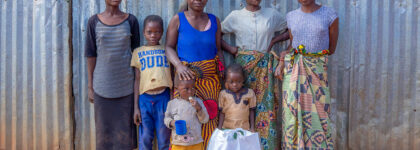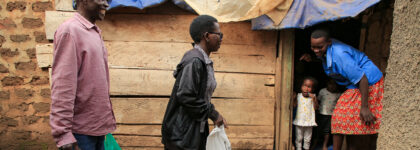In Malawi, nine-year-old Christopher struggles to keep up in school, likely due to cognitive delays caused by ongoing nutritional deficiencies throughout his childhood. In California,…
Zimbabwe isn’t the largest or the smallest country in Africa—it actually stands somewhere in the middle in regard to size and population—but here are a few things that set Zimbabwe apart.
- Victoria Falls is one of the Seven Natural Wonders of the World. Stretching just over a mile wide (1.7 kilometers), Victoria Falls is the world’s largest sheet of falling water. It is over twice as wide and almost twice as tall as Niagara Falls. Located on the border between Zambia and Zimbabwe (and shared by both countries), the falls are formed as the water from the Zambezi River plummets 354 feet (108 kilometers) into a gorge. The noise of Victoria Falls can be heard over 24 miles (40 kilometers) away.

- Lake Kariba is the world’s largest man-made lake and reservoir. In addition to Victoria Falls, Zimbabwe and Zambia also share Lake Kariba, which provides electricity to both countries and supports a thriving fishing industry. Lake Kariba is also home to Nile crocodiles and hippopotami and attracts a wide variety of birds and animals, including elephants, lions, buffalo, cheetah, and antelopes.
- All land and no sea. Zimbabwe is landlocked, meaning it is entirely surrounded by land, without a coastline or access to the sea. There are four countries that share a border with Zimbabwe: Zambia, Mozambique, South Africa, and Botswana.

- Zimbabwe was the last African state to achieve independence from British colonial rule. On April 18, 1980, Zimbabwe raised its flag for the first time to symbolize its independence. The flag’s green stripe represents Zimbabwe’s vegetation and agriculture. The yellow strip represents Zimbabwe’s mineral wealth. The red stripe represents the blood shed during the country’s war of liberation. The black stripe represents the black majority of Zimbabwe. The white triangle represents peace. The red star represents Zimbabwe’s aspirations, and the golden bird is the national emblem of Zimbabwe.
- Zimbabwe has multiple currencies. Due to a period of economic instability that began in 2005, the Zimbabwean dollar began to drastically drop in value. In 2009, the government printed a one hundred trillion dollar banknote, which is the largest denomination ever issued, even though it was only worth about forty cents. The government of Zimbabwe soon abandoned the Zimbabwean dollar and began using other currencies including the US dollar, the South African Rand, euro, the Botswana Pula, the Japanese Yen, Australian Dollar, Indian Rupee, and Chinese Renmindi. The Zimbabwean dollar was reinstated as the local currency in 2018.

- So many languages! In addition to using multiple currencies, Zimbabweans also use many languages. In fact, Zimbabwe holds the world record as the country with the most official languages. Thankfully, English is one of them! The 16 official languages are Chewa, Chibarwe, English, Kalanga, Koisan, Nambya, Ndau, Ndebele, Shangani, Shona, sign language, Sotho, Tonga, Tswana, Venda, and Xhosa.
- Lots of painted rocks. Zimbabwe has the highest concentration of rock art in southern Africa, with thousands of sites throughout the country. The engravings and paintings have been discovered on the walls of caves, rock shelters, and boulders and depict various aspects of daily life for these former inhabitants.

- Mermaids are real! Okay, not really, but in Zimbabwe, there is a strong belief that they exist. In fact, mermaids are often blamed for unfortunate or unexplained occurrences such as disappearances and drownings.
- Athletes from Zimbabwe have won a total of eight Olympic medals. In 1980, the first year Zimbabwe competed in the Olympics as an independent country, the women’s national field hockey team took home the gold medal at the Moscow Olympics. Kirsty Coventry won the other seven medals (two gold, four silver, and one bronze) in swimming in 2004 and 2008.
- Zimbabwe is CHF’s fourth international Mercy Network. The Mercy Network was founded in 2007 during a time of great economic turmoil. Rolling blackouts, unreliable internet, and corruption make Zimbabwe a structurally unstable country. Christ of First Importance Ministries (COFIM), our in-country partner, seeks to grow the next generation’s leaders, starting with local pastors. CHF is blessed with the opportunity to come alongside COFIM and provide mercy ministry training and resources to churches in the Zimbabwe Mercy Network.
These Mercy Network churches are doing more than providing food for families living in poverty in Zimbabwe. Self-sustainability projects and vocational training are giving people a way out of a life of poverty and dependence. The message of the gospel gives people the opportunity to accept eternal salvation.




